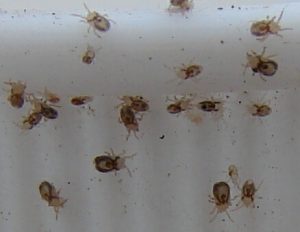 INTRODUCTION: These Mites get their common name of the northern because they occur in temperate or northern regions and of fowl because they are parasites of domestic fowl. They become a structural pest when they migrate from bird nests on buildings and attack humans. They are found throughout temperate regions of the world including the United States.
INTRODUCTION: These Mites get their common name of the northern because they occur in temperate or northern regions and of fowl because they are parasites of domestic fowl. They become a structural pest when they migrate from bird nests on buildings and attack humans. They are found throughout temperate regions of the world including the United States.
RECOGNITION: Adult females are small, about 1/64-1/32” (0.6-1_mm) long, male slightly smaller. Body oval, dorsoventrally flattened (top to bottom), not hard-shelled. Color nearly white when unfed, bright red when recently fed, or gray to black with blood meal partly digested.
HABITS: Problems in structures typically occur when bird nestlings leave the nest. The birds involved are usually pigeons, sparrows, starlings, robins, meadowlarks, grackles, chickens, etc. Hungary nymphs and adults migrate from the abandoned nests. For outside nests, they usually come down the wall and enter via window frames or other openings in the exterior wall. For interior nests, they usually come through the attic and enter via openings in the ceiling or interior wall surfaces. Needless-to-say, if mite populations get very large, at least some of the mites will migrate before nestlings leave.
An unusual habit of the life cycle is that the adults tend to mostly remain on the host. This gives heavily infested birds a grayish to blackish appearance. However, adults can also be found on nest debris as well as in crevices.
CONTROL: Infestations in structures can usually be traced to bird nests in attics, under eaves, on windowsills or flat roots, or in/on chimneys of unused fireplaces. Using an appropriately labeled pesticide, treat the nest(s), remove the nest using the inverted plastic bag technique, and then treat the surfaces where the nest(s) was/were located. In infested rooms of the structure, treat the-Cracks and crevices on the wall(s) and/or ceiling where the mites are entering and/or may be hiding.
In the case of homes, it may be necessary to hot wash and hot dry bedding and clothing left on floor areas.
If people become infested, they can consult with their physician for a prescription or get an over-the-counter lotion labeled for the control of ectoparasitic mites.
